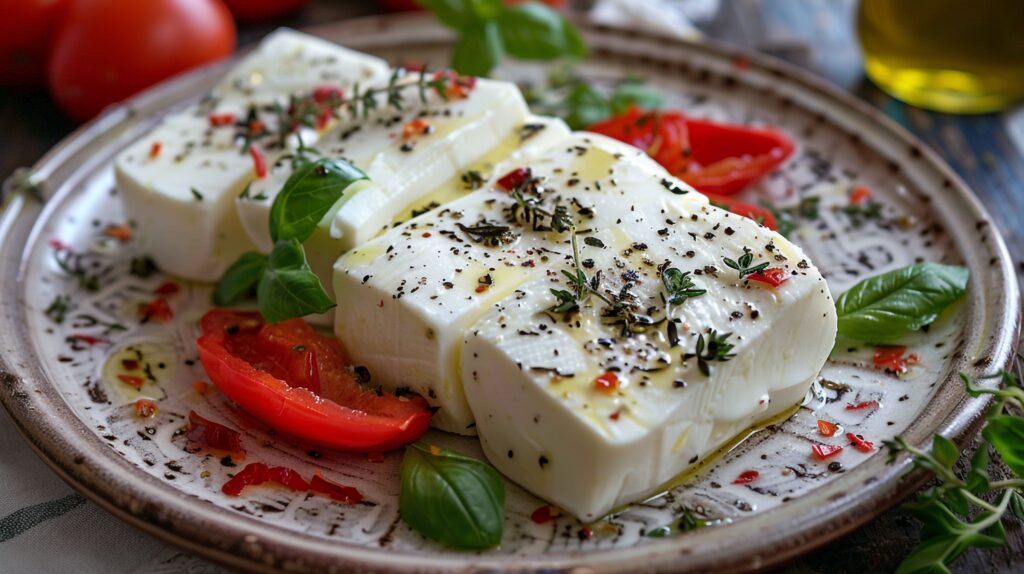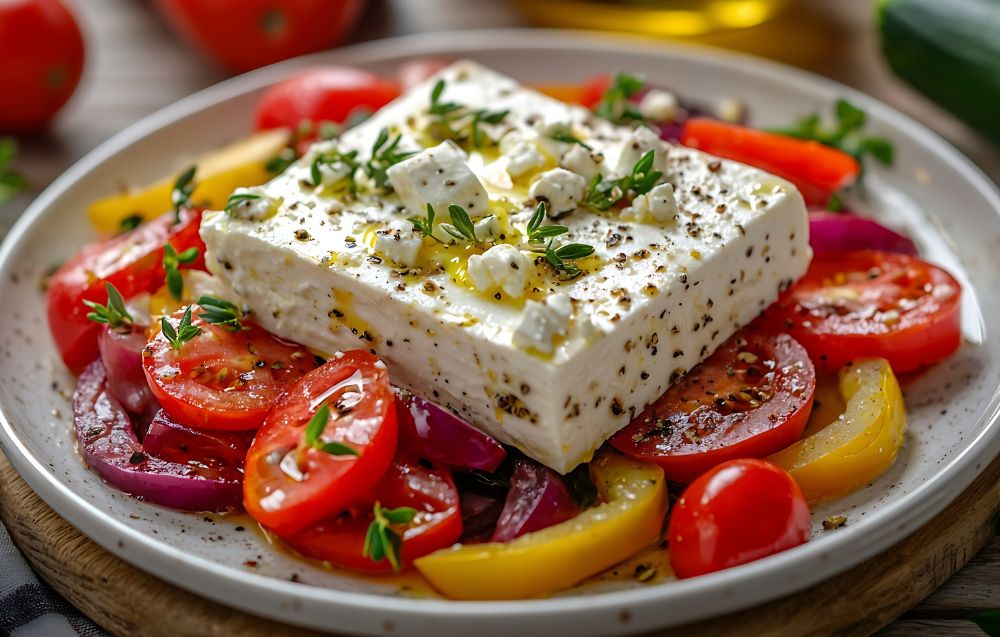When you hear “feta cheese,” what pops into your head? Maybe it’s that tangy crumble on a vibrant Greek salad or its sharp, salty flavor paired with roasted vegetables. But have you ever stopped to wonder, is feta cheese goat cheese? This common question has left many cheese lovers curious about feta’s true origins. While its distinct flavor and texture are unmistakable, what exactly is it made from—goat’s milk, sheep’s milk, or something else entirely? In this post, we’ll unravel the cheesy mystery, diving into the ingredients, origins, and secrets that make feta one of the world’s most beloved cheeses.
Introduction to Feta Cheese
A Brief History of Feta Cheese
Feta cheese has been a culinary staple in the Mediterranean region for centuries. Did you know it’s one of the world’s oldest cheeses? Its history stretches back to ancient Greece, where feta was revered not only for its flavor but also for its significance in Greek mythology. According to the Odyssey, cheese played a vital role in everyday life, offering both nutrition and joy.
“Feta cheese isn’t just food—it’s a link to the rich traditions and culture of Greece.”
Today, it’s a central part of Mediterranean cuisine, symbolizing authenticity and a commitment to preserving time-honored recipes.
How Feta Cheese is Traditionally Made
Crafting feta cheese is a process that combines science and art. Traditionally, cheesemakers use fresh sheep’s milk, often blending it with goat’s milk, to create a delicate balance of flavors. The milk is curdled using rennet, then carefully strained, pressed, and aged in brine for at least two months. This brining step gives feta its signature tang and crumbly texture.
For a deeper dive into the health benefits of feta cheese, check out this guide on whether feta cheese is healthy.
Understanding the Ingredients in Feta Cheese
Goat Milk vs. Sheep Milk: The Key Difference
Here’s where it gets interesting. Feta cheese is not exclusively made from goat milk. Authentic Greek feta typically contains at least 70% sheep’s milk, with up to 30% goat milk added to the mix. Sheep’s milk contributes a rich, creamy texture, while goat’s milk adds an earthy sharpness that balances the flavor.
Is Feta Cheese Always Made from Goat Milk?
Not at all! In fact, some versions of feta don’t include goat’s milk at all. Sheep’s milk dominates the recipe, especially in traditional Greek feta. Variations made outside of Europe, particularly in the U.S., often use cow’s milk, which results in a milder, less tangy cheese. This shift in ingredients alters the texture and flavor profile, making it less “feta-like.”
If you’re curious about how feta compares nutritionally to other cheeses, explore this detailed guide on feta cheese nutrition.
Common Misconceptions About Feta Cheese
Feta vs. Goat Cheese: Are They the Same?
The short answer is no—feta cheese and goat cheese are not the same. While they share a few similarities, like their tangy flavor profiles, they differ in texture, composition, and production. Goat cheese, as the name implies, is made entirely from goat’s milk and is often softer and more spreadable.
“Think of goat cheese as the solo artist and feta as the harmonious duet of sheep and goat milk.”
The Role of Sheep Milk in Feta Cheese
Sheep’s milk is the real MVP in feta production. It’s rich in fat and protein, which lends feta its creamy yet crumbly texture. Without sheep’s milk, feta wouldn’t have its characteristic tang or satisfyingly firm bite.
For ideas on pairing feta cheese with other ingredients, take a look at this post about the best cheeses for mac and cheese.

Types of Feta Cheese Around the World
Greek Feta: The Gold Standard
When you hear “feta,” chances are you’re thinking of Greek feta. Protected by a PDO (Protected Designation of Origin) status, this cheese must be made in Greece using specific methods and milk ratios. It’s tangy, crumbly, and aged to perfection in a salty brine.
French Feta: A Creamy Twist
French feta offers a creamier and milder alternative to the Greek variety. Often made with a higher proportion of goat’s milk, it’s perfect for those who enjoy a softer texture and subtler flavor.
American Feta: Modern Variations
In the United States, feta is often produced with cow’s milk, leading to a firmer, less tangy product. While it may be easier to find, American feta doesn’t quite capture the authentic taste of its Mediterranean counterparts.
Nutritional Profile of Feta Cheese
When you savor the tangy, salty goodness of feta cheese, you’re not just indulging in flavor—you’re treating your body to a nutrient-packed powerhouse. Known for its crumbly texture and bold taste, feta cheese offers an array of health benefits, from supporting bone health to providing a protein boost. But what makes feta stand out nutritionally from other cheeses? Is it the sheep and goat milk blend, its probiotic richness, or something more? Let’s dig into the details and uncover why feta cheese deserves its place as both a delicious indulgence and a healthy choice.
Key Nutrients in Feta Cheese
Feta cheese packs a punch when it comes to essential nutrients:
- Calcium: A single serving of feta cheese provides about 14% of your daily calcium needs, essential for strong bones and teeth.
- Protein: Feta is rich in protein, helping to support muscle repair and overall growth.
- Healthy Fats: Despite being high in fat, feta contains beneficial fatty acids that can support heart health in moderation.
One notable feature of feta is its sodium content. While the brining process is crucial for its flavor, it also makes feta one of the saltier cheeses.
Comparing Feta to Other Cheeses
How does feta cheese stack up against other popular cheeses?
- Compared to cheddar or gouda, feta has fewer calories and less fat, making it a lighter option for cheese lovers.
- Its higher protein-to-calorie ratio makes it an excellent choice for those focusing on a balanced diet.
- The unique blend of sheep and goat milk gives feta its distinct tang and crumbly texture, setting it apart from creamier, cow-milk-based cheeses.
For more insights into cheese production, explore this guide on how cheese is made. It’s a fascinating look at the artistry and science behind every block of cheese.
Benefits of Feta Cheese
Digestive Benefits of Goat and Sheep Milk
One reason feta cheese has gained popularity is that it’s easier to digest than many cow-milk cheeses. This is largely due to the proteins and fats in sheep’s and goat’s milk, which are simpler for the human body to break down.
“If you’ve ever felt bloated or uneasy after consuming cow-milk products, feta might be a better alternative—it’s gentle on the stomach and full of flavor!”
Additionally, feta contains probiotics, those beneficial bacteria that promote gut health. These microbes can aid digestion, enhance nutrient absorption, and even boost your immune system.
High in Calcium and Protein
Feta is a bone-building hero. Its high calcium content, paired with a decent dose of protein, makes it a great addition to your diet, especially for maintaining strong bones and preventing osteoporosis. Women and older adults, in particular, can benefit from incorporating feta into their meals.
Lower in Calories and Fat
For cheese lovers looking to cut back on calories without sacrificing taste, feta is an excellent choice. While it’s not as low-calorie as some non-dairy options, it’s significantly lighter than creamy cheeses like brie or gouda.
Common Problems with Feta Cheese
Lactose Intolerance Concerns
If you’re lactose intolerant, you might assume cheese is off-limits, but feta could be an exception. Because it’s made from sheep and goat milk, which have a different protein structure than cow milk, many people with mild lactose intolerance find feta easier to digest. However, it’s always best to test small amounts first.
For those exploring dairy-free lifestyles, you might enjoy learning about What’s the Best Dairy-Free Option?.
Sodium Content: Is Feta Too Salty?
Yes, feta cheese is salty—but that’s part of its charm. The brining process that gives feta its tangy flavor also contributes to its high sodium levels. If you’re trying to cut back on salt, consider rinsing feta before eating it. This simple step can reduce its sodium content while preserving its delicious taste.
How to Choose the Best Feta Cheese
Recognizing Authentic Feta Cheese
Not all feta is created equal. If you’re looking for authentic, high-quality feta, here’s what to consider:
- Check the Origin: Authentic feta comes from Greece and is made with sheep and goat milk. Look for PDO labels (Protected Designation of Origin) to ensure you’re getting the real deal.
- Texture and Color: True feta is white, crumbly, and slightly creamy. If it’s too firm or yellowish, it might not be authentic.
- Packaging: Authentic feta is often sold in brine. The brine keeps it fresh and enhances the flavor.
Tips for Buying and Storing Feta Cheese
- Buying: Visit specialty stores or farmer’s markets for the best selection. If you’re shopping at a regular grocery store, stick to brands with clear origin labels.
- Storing: Always keep feta submerged in its brine or a homemade saltwater solution. This preserves its texture and prevents drying out.
For those interested in exploring the nutritional benefits of the milk used in feta, take a peek at the detailed breakdown of sheep milk nutrition.
Cooking with Feta Cheese
Feta cheese is a culinary superstar. Whether you’re crumbling it over a salad, blending it into a dip, or baking it into savory pies, its versatility is unmatched. Ready to add some feta magic to your kitchen?
Cooking with Feta Cheese
Feta cheese is one of those ingredients that can turn a good dish into a great one. Its salty tang, creamy-yet-crumbly texture, and bold flavor make it a versatile addition to countless recipes. Whether you’re cooking up a storm or just looking to jazz up a simple meal, feta can be your secret weapon.
Classic Recipes Featuring Feta
Some of the most beloved Mediterranean dishes are built around the magic of feta cheese. Here are a few classics where feta shines:
- Greek Salad: No Greek salad is complete without generous chunks of feta cheese. Its tanginess balances the sweetness of tomatoes, the crunch of cucumbers, and the brininess of olives.
- Spanakopita: This savory Greek spinach pie combines layers of crispy phyllo dough with a rich mixture of spinach, onions, and feta cheese. The feta adds creaminess and a tangy contrast to the earthy spinach.
- Stuffed Peppers: Bell peppers stuffed with a mixture of rice, vegetables, and feta cheese are a comforting and flavorful option for dinner.
Feta also works beautifully as a topping for baked dishes. Sprinkle it over casseroles, lasagnas, or roasted vegetables for a melty, golden crust with a punch of flavor.
Innovative Uses of Feta in Modern Cuisine
Feta isn’t just for traditional Mediterranean recipes—it’s making waves in modern kitchens too. Here are some creative ways to incorporate feta into your meals:
- Feta Pasta: This viral trend involves baking a block of feta with cherry tomatoes, olive oil, and seasonings until creamy, then mixing it into cooked pasta. The result is a rich, tangy, and incredibly easy dish.
- Feta Omelette: Add crumbled feta to your morning omelette for a cheesy, tangy upgrade. Pair it with fresh herbs like dill or parsley for a Mediterranean twist.
- Feta on Pizza: Swap out mozzarella for feta on your pizza for a bold and unique flavor. Combine it with toppings like spinach, sun-dried tomatoes, and artichokes for a Mediterranean-inspired pie.
Feta’s versatility even extends to snacks and appetizers. Blend it with yogurt and herbs for a creamy dip or serve it as part of a charcuterie board alongside fresh fruits and nuts.
Substitutes for Feta Cheese
What if you’re out of feta or need an alternative for dietary reasons? Don’t worry—there are plenty of substitutes that can deliver a similar taste or texture.
Alternatives for Goat Cheese Lovers
If you’re looking for a substitute that still offers a tangy, earthy flavor, consider these options:
- Goat Cheese: While softer and creamier than feta, goat cheese shares a similar tangy profile. It works well in salads, spreads, and baked dishes.
- Ricotta Salata: This Italian cheese is firmer and less salty than feta but has a mild, nutty flavor that pairs well with many of the same dishes.
- Queso Fresco: A Mexican cheese that’s slightly milder than feta, queso fresco has a crumbly texture and a light, salty taste.
Non-Dairy Options for Vegan Diets
For those who follow a vegan diet, there are plant-based alternatives that mimic the flavor and texture of feta cheese:
- Tofu Feta: Marinating tofu in olive oil, lemon juice, and spices creates a tangy, crumbly cheese substitute that’s surprisingly close to the real thing.
- Nut-Based Cheese: Many vegan cheeses are made from almonds, cashews, or macadamia nuts. These often have a creamy texture and can be flavored to replicate feta’s tangy bite.
The Science Behind Feta’s Flavor
What gives feta its unique taste and texture? The answer lies in the science of cheese-making.
The Role of Brining
Feta is aged in a brine solution, which does two important things:
- Preserves the Cheese: The salty brine prevents harmful bacteria from growing, allowing feta to stay fresh for months.
- Enhances the Flavor: The cheese absorbs salt from the brine, giving it that distinctive tangy, savory taste.
Brining also contributes to feta’s crumbly texture. The salt pulls moisture from the cheese, creating a dense, firm structure that crumbles beautifully.
Milk Composition Matters
The type of milk used in feta production plays a huge role in its flavor and texture. Sheep’s milk is higher in fat and protein, giving feta its creamy richness, while goat’s milk adds a sharp, earthy note. The balance of these two milks creates the complex, layered flavor profile that sets feta apart from other cheeses.
Healthier Ways to Enjoy Feta
While feta is delicious, its high sodium content can be a concern for some people. Here are a few tips to enjoy feta in a healthier way:
- Rinse It: Rinsing feta under cold water can remove some of the surface salt, reducing its sodium content.
- Pair It with Fresh Ingredients: Balance feta’s saltiness by pairing it with fresh vegetables, fruits, and whole grains. For example, a quinoa salad with cucumbers, tomatoes, and feta is a light and flavorful dish.
- Use It as a Garnish: Instead of making feta the star of the dish, use it as a finishing touch. A sprinkle of crumbled feta goes a long way in adding flavor without overloading on calories or salt.
Conclusion: Is Feta Cheese Goat Cheese?
So, is feta cheese goat cheese? Not exactly. While goat’s milk plays a role in feta’s production, sheep’s milk is the primary ingredient that gives feta its rich, tangy flavor and creamy texture. Together, these two milks create a cheese that’s uniquely versatile, nutritious, and utterly delicious.
Whether you’re enjoying feta in a traditional Greek dish or experimenting with modern recipes, it’s clear that this cheese is much more than just an ingredient—it’s an experience. So go ahead, crumble a little feta over your next meal, and savor the magic of this Mediterranean treasure!

